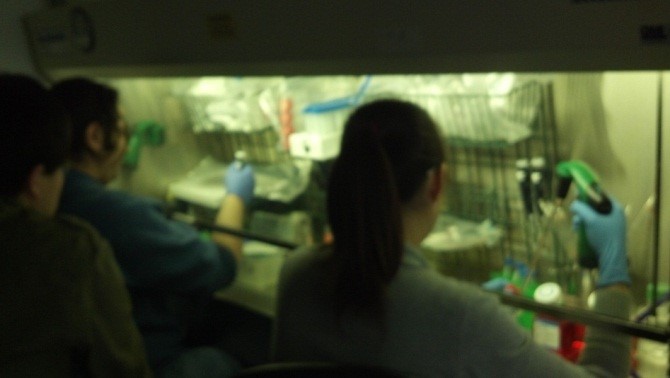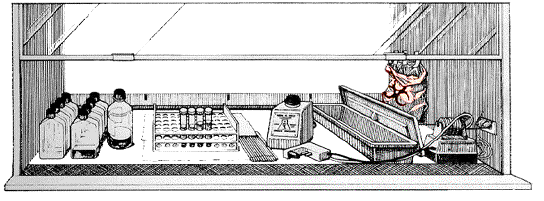Biological Safety Cabinets
The Biological Safety Cabinet (BSC) protects the researcher, the research materials, and other lab members through a simple system of airflow and filters. A BSC must be used whenever activities are anticipated to generate droplets, splashes, and aerosols with potentially infectious biological materials.
Engineering controls are an effective tool for reducing exposure to biological materials. Examples of engineering controls used in laboratories at Cornell may include dilution ventilation, local exhaust ventilation, biological safety cabinets, glove boxes, safety shields, and proper storage facilities.
The OSHA Laboratory Standard requires that "fume hoods and other protective equipment function properly and that specific measures are taken to ensure the proper and adequate performance of such equipment." The OSHA Bloodborne Pathogens Standard requires all labs working human derived materials have certified biosafety cabinets. Various groups conduct periodic inspections and maintenance of protective equipment within and outside Cornell. Biosafety cabinets, in particular, need annual NSF/ANSI Standard 49 certification testing. Currently, certification is conducted by an outside Cornell contractor.
Training
The principal Investigator is responsible for training, which may be accomplished using various methods and must be documented by the laboratory. Online training is available through Workday Learning. Lab supervisors should augment training with training in the lab.
Operating in the BSC
Protect yourself from and prevent contamination of your work by always wearing a buttoned-up lab coat and gloves at a minimum. Be consistent. Any time you leave the BSC, remove gloves and decontaminate items to be removed.
Plan and take only what you need into the BSC. Remember to include waste collection supplies (e.g., biohazard bags, sharps disposal containers). Use slow, controlled hand and arm motions inside the cabinet, and move your hands in and out of the cabinet in a linear, not radial, fashion. Work at least 6 inches inside the cabinet, with a workflow of clean-to-dirty materials. The location of the BSC in the room also matters due to potential cross-drafts. People walking by can create turbulence, potentially pulling aerosols out of the cabinet or causing dirty air to contaminate material inside the BSC. Two people working in BSC is only acceptable if the work is compatible and the cabinet is large enough - typically 8 feet.
Decontamination and Cleaning
Decontaminate the BSC before and after every use to prevent cross-contamination. One method is to use a 1:10 fresh bleach solution followed by a 70% ethanol rinse to avoid corrosion and achieve good disinfection. Contact EHS if you need a bleach alternative. Reaching the back and sides of the biosafety cabinet can be difficult. To avoid sticking your head in the BSC or possibly injuring yourself, use a Swiffer-style mop handle to clean those areas. Occasionally clean and decontaminate the space below the work surface, accumulating broken glass, spilled materials, and general gunk. Use tongs to remove broken glass. Establish a regular schedule to perform this activity, perhaps once or twice a year and as needed.
Before service or removal of a biosafety cabinet, the laboratory must clear the cabinet of all items. In addition, users must disinfect all surfaces with an appropriate disinfectant.
Things to avoid when using a BSC
- Don't rely on UV – UV light only works on surfaces, not what's underneath. Dust and other materials condense on the bulb, and the germicidal functions burn out long before the blue light does. The bulb should be dusted weekly and should be changed annually. UV can be a supplemental treatment, but good chemical disinfection is much more reliable.
- Don't spray corrosive disinfectants – use a squirt or drizzle bottle to apply disinfectants such as bleach. Follow with an ethanol rinse to prevent corrosion and damage to the BSC's internal parts.
- Don't block the grills or clutter the BSC - Blocking the front or back perforated grill and cluttering your work surface negatively affects airflow and containment of aerosols.
- Don't raise the sash - BSCs are designed to operate at a fixed sash height (this is very different from a chemical fume hood).
- Don't use volatile or flammable chemicals - BSCs are not designed to filter or contain chemicals so that they will recirculate back into the room. You and your colleagues may breathe them in when they recirculate into the room. Volatile or flammable chemicals may cause an explosion upon contact with electrical parts by becoming concentrated inside the BSC.
- Don't use Bunsen Burners inside the BSC - they create unnecessary fire hazards, explosion hazards (if there is a gas connection), and air turbulence. Many safer alternatives, including the Bacticinerator, the Flame Boy, and others (contact EHS).
Procedure for Purchase of a Biosafety Cabinet
- Contact EHSBiosafety at askEHS@cornell.edu with the intent to purchase a cabinet. Provide information on the scope of work (e.g., biomaterials and equipment)to be done and the location.
- EHS/Biosafety will schedule a time to visit the space and provide an assessment of suitability. Generally:
- Biosafety cabinets may not be placed under ventilation.
- Biosafety cabinets may not be placed opposite doorways or other openings in a room.
- After an on site assessment, the facility will need to work directly with Cornell procurement and provide the assessment to purchase the cabinet. Biosafety cabinets are not available for purchase in e-Shop.
Procedure for Certification of a Biosafety Cabinet
The National Sanitation Foundation (NSF) International Standard no. 49 for Class II biohazard cabinetry establishes performance criteria and minimum requirements for design, manufacture, and testing.
- A BSC in a BSL1 and BSL2 laboratory must be professionally certified after installation annually recertified and after being moved or service repair.
- A BSC in a BSL3 laboratory must be certified after installation, annually recertified, and after being moved or a serviced repair. At Cornell, these cabinets are certified every six months.
Integra Testing, a subsidiary of Steris Life Sciences, is a contracted company that supplies services to the Cornell community at a negotiated price point. Please request service with Integra Testing if you are experiencing problems with your biosafety cabinet or certification is close to expiration or expired. No work is permitted in biosafety cabinets without certification or with expired certification.
To request service with Integra Testing, please visit their website or contact them by phone at 800-523-9852 x 43682. Certification services are not available in e-Shop.
Disposal of Biosafety Cabinets
Laboratories are responsible for ensuring the proper disposal of biosafety cabinets.
- Contact EHS/Biosafety at askEHS@cornell.edu to provide an assessment of the required decontamination.
- Surface decontaminate the BSC.
- Contact Integra Testing to request decontamination to decontaminate the entire BSC, including the filters.
- Ensure the vendor removes the filters and provides confirmation of decontamination to the laboratory representative. Cornell's Facilities Management will require confirmation for the next steps.
- Ensure signage is placed on the outside of the cabinet, which indicates that it was decontaminated as per the methods outlined Biological Decontamination of Laboratory Equipment; the approved signage is in the method.
- Contact Facilities Management at recycle@cornell.edu to request a pick-up for the filters and BSC.
Training Resources
Guidelines
Regulations
More Information
- Review Section 3.2 of the Biosafety Manual
- Attend “Working Safely in Biosafety Cabinets and Other Hoods” class – find it in Workday Learning as CVM 1074, "Working Safely in Biosafety Cabinets and other Hoods"
- Contact the Biosafety team at askEHS for tailored, hands-on BSC training in your lab or at our training lab, or for help finding an alternative to your Bunsen Burner. If you work at the College of Veterinary Medicine, you can also request this from Paul Jennette.
- Check out our related GBPs on aerosol-producing equipment, aspirator set up, and other items that might impact the way you use your BSC
- Check out our Cornell EHS YouTube channel that features biosafety cabinet videos - Cornell University Video - Techniques for Working Safely in a Biosafety Cabinet
- Biosafety Cabinet (BSC) is past due certification



